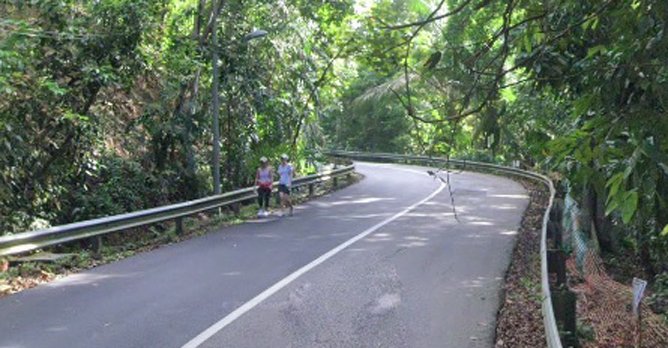Watch out for these hazardous road surfaces if you don't want to get into an accident!
10 Mar 2023|182,120 views
Since young, we have been taught to always look both ways when crossing the road, never to dash across, and more. As a motorist, we are forced to purchase vehicle insurance and are heavily penalised when we break traffic regulations. It all points towards the same consensus - roads are dangerous.
But if you think pedestrians and other road users are the only cause of concern, then you couldn't be more wrong. Roads aren't made equal, hence you always read about how certain countries have better road quality than others. And we aren't even talking about things like the design of traffic junctions, but rather, the quality of road surfaces. So, here are some hazards on road surfaces that you should look out for while driving.
Potholes
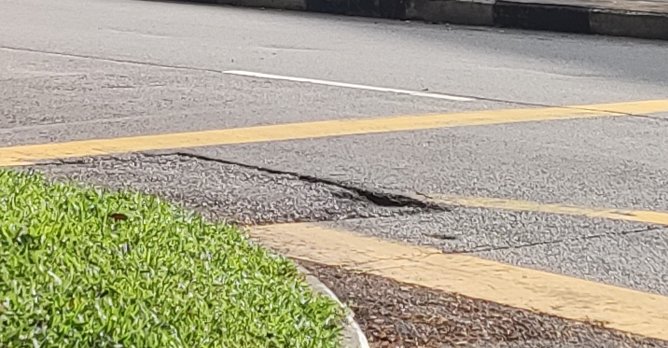
Hence, you can thank the recent rainy weather for the sharp rise in the numbers of potholes on our roads. Potholes pose a hazard to all road users - they can cause damage to the undercarriage components and the wheels of a car, and can easily cause an accident if a cyclist or motorcyclist were to ride into one.
When the road is wet, potholes can also be obscured by pooling water and appears as deceivingly shallow-looking puddles. Due to this occurrence, it would be wise to avoid puddles as much as possible.
Standing water and puddles
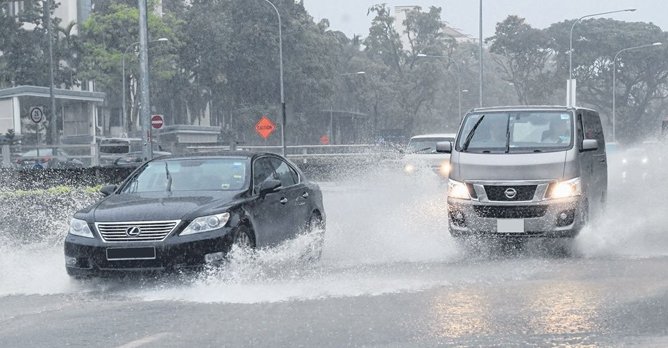
With degraded and uneven road surfaces, or simply when the amount of rainwater overcomes the drainage capacity of the road, puddles and bodies of standing water can form.
Standing water on the road surface is frowned upon for several reasons. If your car is travelling at speed, its tyres might not be able to displace the water in time, resulting in aquaplaning. Aquaplaning occurs when the tyres briefly ride atop the water surface. This can result in a dangerous momentary loss of control.
Another issue from puddles is when the water displaced by a vehicle ends up splashing onto the windscreen of another vehicle. This can result in a momentary loss of visibility as the windscreen is completely obscured by the splash of water. This can easily result in an accident if the driver were to panic or lose control of the car.
Expressway expansion joints
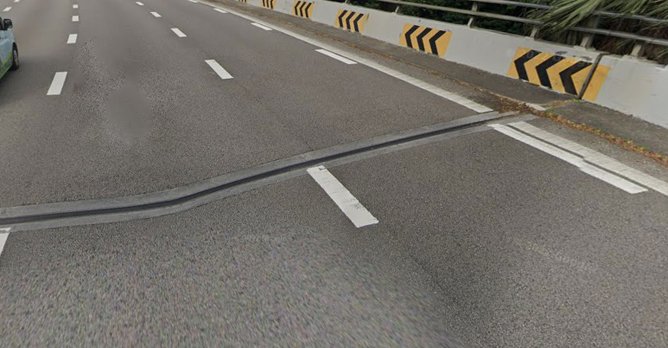
Expansion joints usually result in a small gap, and they are sometimes made of metal and can be rather slick when wet. The unexpected bump and the combination of a small slick patch in the wet can unsettle a car, especially if the expansion joint is in the middle of a bend.
Thankfully, staying safe is rather simple. Driving at a lower speed in adverse weather conditions on the expressway (especially in the bends) can minimise the possibility of losing control of your car due to expansion joints.
Off-cambered bends
Off-cambered bends are bends where the outer edge of the road is lower than the inner edge of the road. When driving on such roads, it feels as though your car is going to roll or slide off the outer edge.
In a car, going at speed, off-cambered bends can promote understeer causing you to end up in the guardrails at the outer edge of the road. However, such roads are particularly hazardous to those on two-wheelers as it can easily cause the tyres to start slipping.
Drivers who are going too fast and getting caught unaware can easily get into an accident in off-cambered bends, and the issue gets compounded if the road surface is wet. To stay safe, you should avoid excessive speed if you foresee an off-cambered bend.
Unevenly patched roads
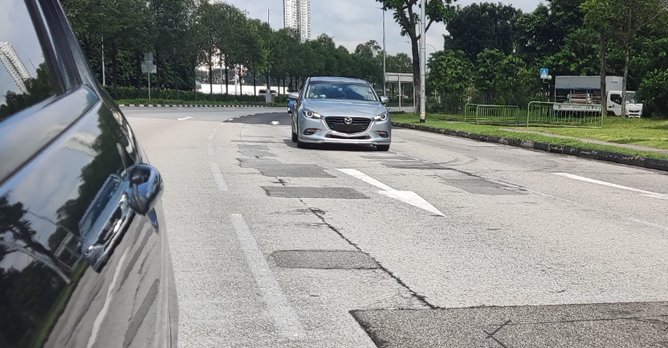
Save for a complete resurfacing, patched sections of roads tend to be uneven (this includes pothole repairs), which can be rather annoying to drive on.
And annoyance isn't the only issue here. In certain situations, the uneven surface can also result in a phenomenon known as tramlining. Tramlining refers to the tendency for a car's tyres to track and follow the uneven surface, resulting in unpredictable and erratic steering. The problem is aggravated if you are on a two-wheeler.
Sandy roads
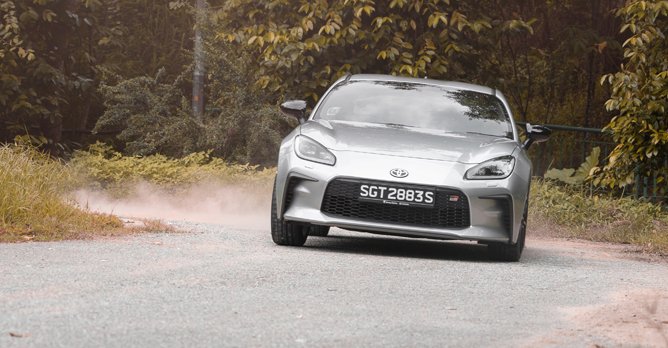
Sand on the road surface can result in a sudden, drastic reduction of grip. And if you were going at speed, losing traction due to a sandy patch of road is definitely a scary and dangerous situation. Furthermore, chances are by the time you realise the surface of a road is sandy, it would have been too late to slow down or react to it.
For those who are on two-wheels, hitting a sandy patch while trying to negotiate a turn can quickly cause the bike to slip and end with you landing on the rough and hard road surface. Hence, one should always be particularly careful when navigating through stretches of roads that are likely to be sandy - such as roads that are less populated, and roads frequented by construction and heavy vehicles.
Now that you understand how road surfaces can play a huge part in your safety while driving or riding on the roads, you'll know what to look out for. As a rule of thumb, avoid speeding, ride or drive defensively and you should be fine for the most parts.
Here are some other articles that you might be interested in:
Common car grooming myths busted
8 most affordable turbocharged new cars for a faster 2023
Never commit these acts of road rage while driving, no matter how angry you are
Here's how you can drive a manual transmission equipped car like a professional driver

Sgcarmart
Get up to 20% off and $300 cashback when you renew with select car insurance!
Compare car insurance effortlessly with Sgcarmart. Get exclusive offers, discounts and cashback when renewing car insurance with our partner.
- Auto comparison for your future renewal quotes
- We provide claims support for your accident claims
Since young, we have been taught to always look both ways when crossing the road, never to dash across, and more. As a motorist, we are forced to purchase vehicle insurance and are heavily penalised when we break traffic regulations. It all points towards the same consensus - roads are dangerous.
But if you think pedestrians and other road users are the only cause of concern, then you couldn't be more wrong. Roads aren't made equal, hence you always read about how certain countries have better road quality than others. And we aren't even talking about things like the design of traffic junctions, but rather, the quality of road surfaces. So, here are some hazards on road surfaces that you should look out for while driving.
Potholes

Hence, you can thank the recent rainy weather for the sharp rise in the numbers of potholes on our roads. Potholes pose a hazard to all road users - they can cause damage to the undercarriage components and the wheels of a car, and can easily cause an accident if a cyclist or motorcyclist were to ride into one.
When the road is wet, potholes can also be obscured by pooling water and appears as deceivingly shallow-looking puddles. Due to this occurrence, it would be wise to avoid puddles as much as possible.
Standing water and puddles

With degraded and uneven road surfaces, or simply when the amount of rainwater overcomes the drainage capacity of the road, puddles and bodies of standing water can form.
Standing water on the road surface is frowned upon for several reasons. If your car is travelling at speed, its tyres might not be able to displace the water in time, resulting in aquaplaning. Aquaplaning occurs when the tyres briefly ride atop the water surface. This can result in a dangerous momentary loss of control.
Another issue from puddles is when the water displaced by a vehicle ends up splashing onto the windscreen of another vehicle. This can result in a momentary loss of visibility as the windscreen is completely obscured by the splash of water. This can easily result in an accident if the driver were to panic or lose control of the car.
Expressway expansion joints

Expansion joints usually result in a small gap, and they are sometimes made of metal and can be rather slick when wet. The unexpected bump and the combination of a small slick patch in the wet can unsettle a car, especially if the expansion joint is in the middle of a bend.
Thankfully, staying safe is rather simple. Driving at a lower speed in adverse weather conditions on the expressway (especially in the bends) can minimise the possibility of losing control of your car due to expansion joints.
Off-cambered bends
Off-cambered bends are bends where the outer edge of the road is lower than the inner edge of the road. When driving on such roads, it feels as though your car is going to roll or slide off the outer edge.
In a car, going at speed, off-cambered bends can promote understeer causing you to end up in the guardrails at the outer edge of the road. However, such roads are particularly hazardous to those on two-wheelers as it can easily cause the tyres to start slipping.
Drivers who are going too fast and getting caught unaware can easily get into an accident in off-cambered bends, and the issue gets compounded if the road surface is wet. To stay safe, you should avoid excessive speed if you foresee an off-cambered bend.
Unevenly patched roads

Save for a complete resurfacing, patched sections of roads tend to be uneven (this includes pothole repairs), which can be rather annoying to drive on.
And annoyance isn't the only issue here. In certain situations, the uneven surface can also result in a phenomenon known as tramlining. Tramlining refers to the tendency for a car's tyres to track and follow the uneven surface, resulting in unpredictable and erratic steering. The problem is aggravated if you are on a two-wheeler.
Sandy roads

Sand on the road surface can result in a sudden, drastic reduction of grip. And if you were going at speed, losing traction due to a sandy patch of road is definitely a scary and dangerous situation. Furthermore, chances are by the time you realise the surface of a road is sandy, it would have been too late to slow down or react to it.
For those who are on two-wheels, hitting a sandy patch while trying to negotiate a turn can quickly cause the bike to slip and end with you landing on the rough and hard road surface. Hence, one should always be particularly careful when navigating through stretches of roads that are likely to be sandy - such as roads that are less populated, and roads frequented by construction and heavy vehicles.
Now that you understand how road surfaces can play a huge part in your safety while driving or riding on the roads, you'll know what to look out for. As a rule of thumb, avoid speeding, ride or drive defensively and you should be fine for the most parts.
Here are some other articles that you might be interested in:
Common car grooming myths busted
8 most affordable turbocharged new cars for a faster 2023
Never commit these acts of road rage while driving, no matter how angry you are
Here's how you can drive a manual transmission equipped car like a professional driver

Sgcarmart
Get up to 20% off and $300 cashback when you renew with select car insurance!
Compare car insurance effortlessly with Sgcarmart. Get exclusive offers, discounts and cashback when renewing car insurance with our partner.
- Auto comparison for your future renewal quotes
- We provide claims support for your accident claims







